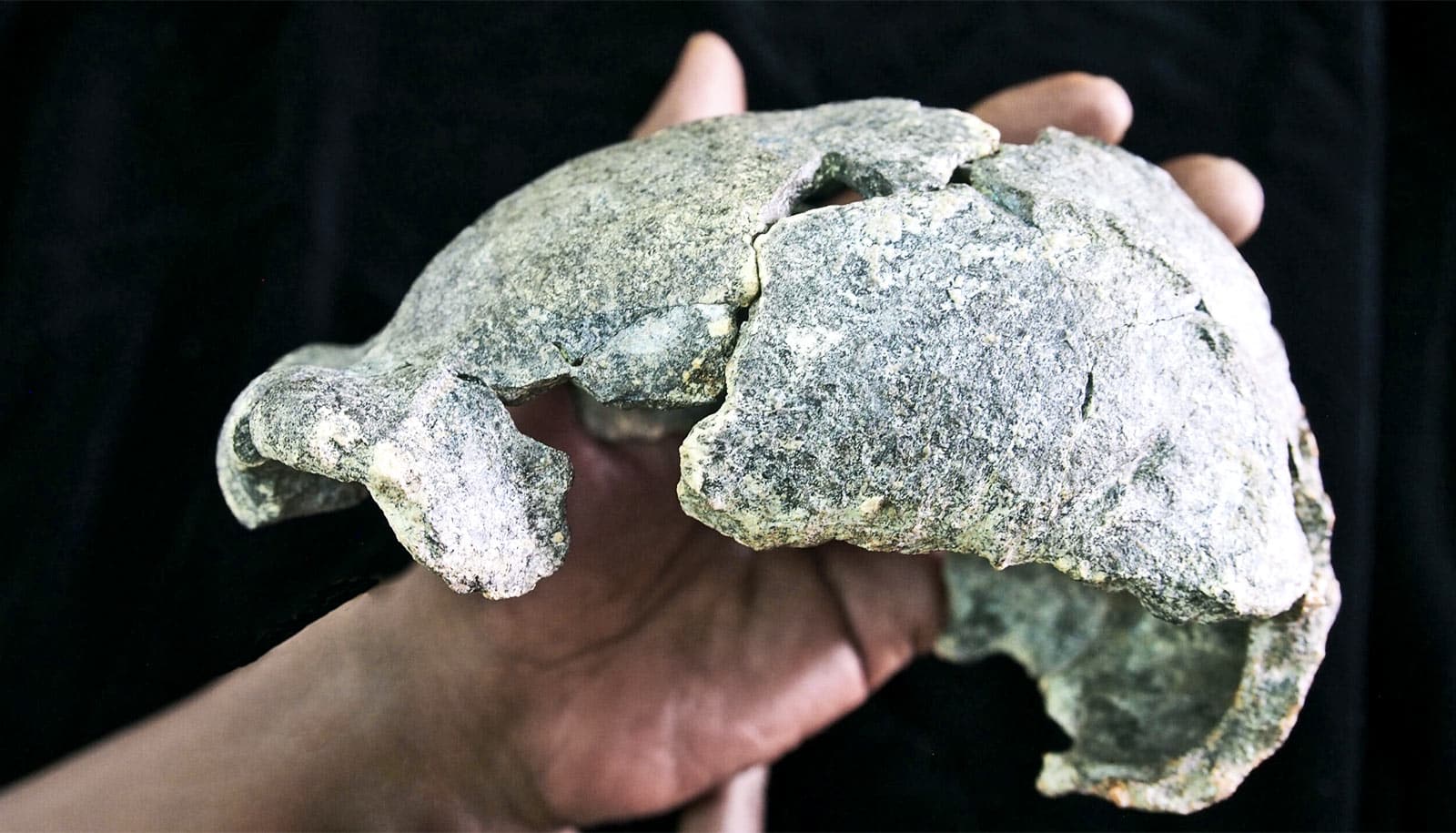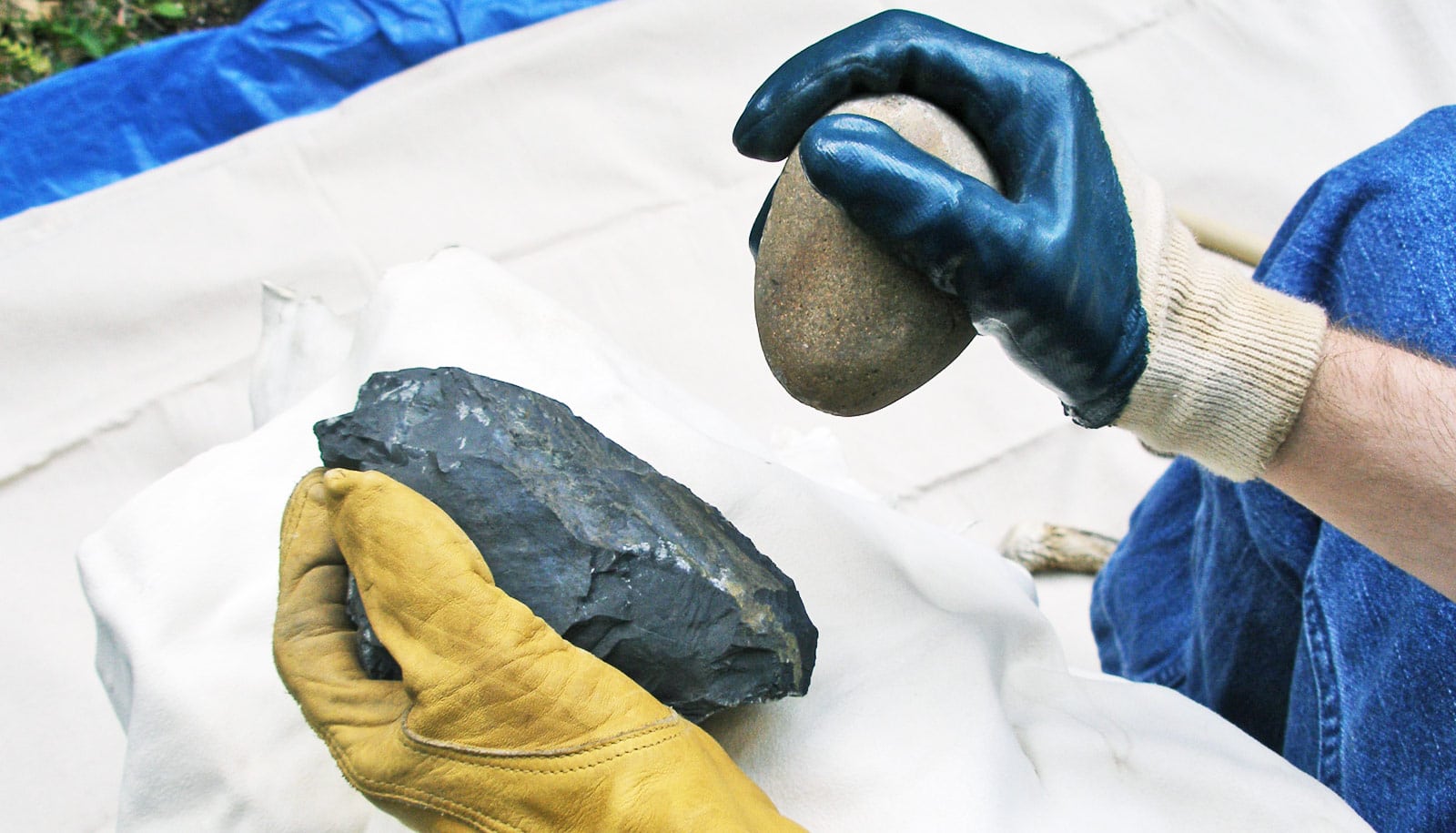Researchers have discovered a nearly complete Homo erectus cranium, estimated to about 1.5 million years ago, at a dig in Gona, Ethiopia.
They also found a partial cranium dated to about 1.26 million years ago. Both crania were associated with simple Oldowan-type (Mode 1) and more complex Acheulian (Mode 2) stone tool assemblages.
This suggests that H. erectus had a degree of cultural/behavioral plasticity that researchers don’t yet fully understand.
Gona is located in the Afar Triangle of Ethiopia, adjacent to the well-known Middle Awash and Hadar study areas, where researchers found the famous skeletons “Ardi” and “Lucy,” respectively.

They discovered the nearly complete cranium at Dana Aoule North (DAN5), and the partial cranium at Busidima North (BSN12), sites 5.7 kilometers (about 3.5 miles) apart. The research team has been investigating the Gona deposits since 1999. The researchers discovered the partial cranium in the first season and the complete cranium a year later on a camel trail.
Homo erectus diet
Researchers say while the partial cranium is robust and large, the complete cranium is smaller and more gracile, suggesting that H. erectus was probably a sexually dimorphic species. Remarkably, the DAN5 cranium has the smallest endocranial volume documented for H. erectus in Africa, about 590 cubic centimeters, probably representing a female.
The smallest Homo erectus cranium in Africa, and the diverse stone tools found at Gona, show that human ancestors were more varied, both physically and behaviorally, than previously known, the researchers say.
The physical diversity is mirrored by the stone tool technologies exhibited by the artifacts found with both crania. Instead of only finding the expected large hand axes or picks, signature tools of H. erectus, the team also found both well-made hand axes and plenty of less-complex Oldowan tools and cores.
The toolmakers at both sites lived in close proximity to ancient rivers, in settings with riverine woodlands adjacent to open habitats. The low δ13C isotope value from the DAN5 cranium is consistent with a diet dominated by plants, including trees and shrubs, and/or animals that ate food from trees or shrubs, or, alternatively, broad-spectrum omnivory.
Stone tool diversity
Naomi Levin, a geologist at the University of Michigan, coordinated the effort to date the fossils and to determine their environmental context.
To date the fossils, researchers used a variety of techniques: standard field mapping and stratigraphy, as well as analyses of the magnetic properties of the sediments, the chemistry of volcanic ashes, and the distribution of argon isotopes in volcanic ashes.
“Constraining the age of these sites proved particularly challenging, requiring multiple experts using a range of techniques over several years of field work,” says Levin, an associate professor in the earth and environmental sciences department and in the Program in the Environment.
“This is a great example of scientific detective work and how science gets done, drawing on a community of scholars and their collective knowledge of the geology of eastern Africa,” says Levin, who co-directs an isotope geochemistry lab that conducts studies of ancient environments using carbon and oxygen isotopes.
Along with University of Arizona geologist Jay Quade, Levin also coordinated the environmental reconstruction of the Gona sites.
At the Gona study area in Ethiopia’s Afar State, H. erectus used locally available stone cobbles to make their tools, found in nearby riverbeds. Fossil fauna were abundant at the BSN12 site, but cut marks or hammerstone-percussed bones were not identified.
At the DAN5 site, an elephant toe bone was found with stone tool cut marks, and a small antelope leg bone had a percussion notch, suggesting that H. erectus butchered both large and small mammals, though it is not clear whether they hunted or scavenged their prey.
“The simple view that a single hominin species is responsible for a single stone tool technology is not supported.”
There is a common view that early Homo (e.g., Homo habilis) invented the first simple (Oldowan) stone tools, but when H. erectus appeared about 1.8 to 1.7 million years ago, a new stone tool technology called the Acheulian, with purposefully shaped large cutting tools such as hand axes, emerged in Africa.
The timing, causes, and nature of this significant transition to the Acheulian by about 1.7 million years ago is not entirely clear, though, and is an issue debated by archaeologists.
‘Human evolutionary story is complicated’
Investigations at both sites clearly show that Oldowan technology persisted much longer after the invention of the Acheulian, suggesting a particular behavioral flexibility and cultural complexity practiced by H. erectus, a trait not fully understood or appreciated in paleoanthropology, the researchers say.
“Although most researchers in the field consider the Acheulian to have replaced the earlier Oldowan (Mode 1) by 1.7 Ma, our research has shown that Mode 1 technology actually remained ubiquitous throughout the entire Paleolithic,” says Sileshi Semaw of the Centro Nacional de Investigación sobre la Evolución Humana (CENIEH) in Spain.
“The simple view that a single hominin species is responsible for a single stone tool technology is not supported,” says Michael J. Rogers of Southern Connecticut State University. “The human evolutionary story is more complicated.”
Both sites at Gona are among the earliest examples of H. erectus associated with both Oldowan and Acheulian stone assemblages.
“In the almost 130 years since its initial discovery in Java, H. erectus has been recovered from many sites across Eurasia and Africa. The new remains from the Gona study area exhibit a degree of biological diversity in Africa that had not been seen previously, notably the small size of the DAN5 cranium,” says coauthor Scott Simpson of Case Western Reserve University.
“The BSN12 partial cranium also provides evidence linking the African and eastern Asian fossils, demonstrating how successful Homo erectus was.”
In Africa, some argue that multiple hominin species may have been responsible for the two distinct contemporary stone technologies, Oldowan and Acheulian. To the contrary, the new evidence from Gona suggests a lengthy and concurrent use of both Oldowan and Acheulian technologies by a single long-lived species, H. erectus, the variable expression of which deserves continued research, according to the researchers.
“One challenge in the future will be to understand better the stone tool attributes that are likely to be passed on through cultural tradition versus others that are more likely to be reinvented by different hominin groups,” Rogers says.
The paper appears in Science Advances.
Source: University of Michigan


